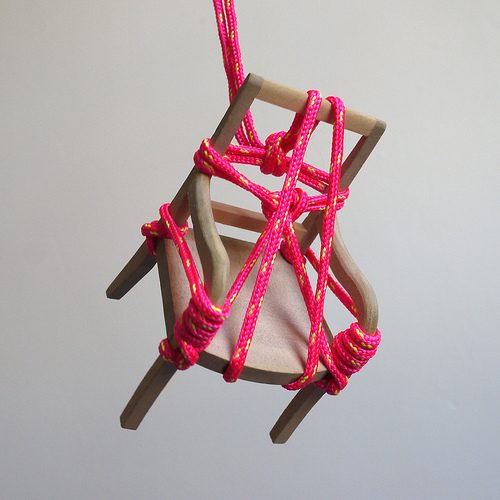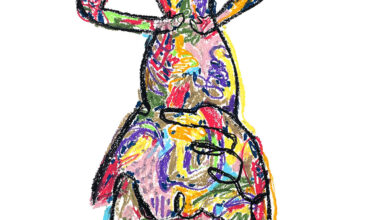Kennedy James (previously known as Jimmy Owenns) is an award winning visual artist working with installation, drawing, video, photography and music. Born in France in 1981, she recently moved to NYC. She is represented by the Galerie Vanessa Quang in Paris and has shown her works in the USA, Europe, China and Japan. Her work is held in numerous public and private collections including the MoMA of Shanghai.
“Since 1998, I”ve been exploring the notions of the splitting (of perception, narration and psyche) and identity. Following this, I started working with videos in 2004 to question the cinema”s narration and construction. Nowadays, I”m interested into developing further more my fascination for the Japanese culture and its folklore which always has been a continuous inspiration to my work since the beginning.”
The installation series “Serial Bondage” caught our attention, and we were curious about its influences and origins.
This work consists in Victorian style armchairs and chairs tied up and harnessed in the ancient art of Japanese Shibari (rope bondage). The chairs used are usually Louis XV, Napoleon III or Voltaire style, because of their voluptuous design which makes the piece very anthropomorphic.
Shibari is an ancient Japanese form of erotic and aesthetic expression and, as you”ll find out, Kennedy James is very enthusiastic about Japanese culture, its aesthetics, codes and rituals. She considers herself a child of this generation, growing up watching japanese anime and reading mangas, and also she had the chance to share with her parents the love for the asian culture.
Shibari is a sophisticated, complex and technical ritual; the physical representation of the dominative/submissive relationship found at every social level of Japanese society.
The practice has more in common with sculpture and corporal architecture than simple sensual practice.
As in every other Japanese ritual (like ikebana or the floral arrangement, the tea ceremony, the art of wearing a kimono), Shibari is about ancestral rules and strict aesthetic casino online standards. These rituals illustrate a typical desire of the Japanese culture: restrain the nature in order to control the wild aspect of life.
Originally the Shibari art was used by soldiers (in the pay of Samurais) to immobilize war prisoners. During the Edo period (1600-1868) it became a method of punishment and a strict code began to govern its use.
The rope had different colors corresponding to the time of the year and the position of prisoner depended on the time of season. During centuries the rules evolved to where the colors of the rope and the bondage patern would reflect the profession, type of crime and social position of the criminal.
The most curious thing is that Kennedy James doesn”t know how this bondage on chairs concept began. In her point of view, the chair is the most submissive piece of furniture we can find and it”s appearance is so anthropomorphic, that it becomes the perfect subject – the chair is also a very subtle object, “Subtlety is a major line in my work. I like that the Serial Bondage series will always make the viewer wonder and think about the piece or even start imagining a more kinky scenery (and then being less subtle). But the pieces are very innocent from my point of view. It is only the interpretation of the viewer which make it something erotic.”
Kennedy”s main interest is the interpretation of the viewer. In a sense, she”s trying to make strange or strong pieces only to find the interpretation and excite the imagination of the people seeing the pieces. “I guess that at this point i should say that I”m the kid of a psychiatrist, interpretation is the key!” she says.
By Mafalda Leite














